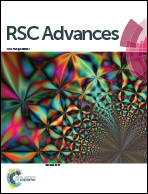Enhanced catalytic activity and thermal stability of lipase bound to oxide nanosheets
Abstract
The present study reports the effects of binding of lipase, which is an inexpensive digestive enzyme (candida antarctica lipase) that catalyzes the hydrolysis reaction and is frequently utilized for artificial synthesis of a variety of organic molecules, to titanate nanosheets (TNSs) on their biocatalytic activities and stabilities under several lipase concentrations. TNSs were prepared through a hydrolysis reaction of titanium tetraisopropoxide (TTIP) with tetrabutylammonium hydroxide (TBAOH), resulting in formation of a colorless and transparent colloidal solution including TNSs with nanometric dimensions (hydrodynamic diameter: ca. 5.6 nm). TNSs were bound to lipase molecules through electrostatic interaction in an aqueous phase at an appropriate pH, forming inorganic-bio nanohybrids (lipase–TNSs). The enzymatic reaction rate for hydrolysis of p-nitrophenyl acetate (pNPA) catalyzed by the lipase–TNSs, especially in diluted lipase concentrations, was significantly improved more than 8 times as compared with free lipase. On the other hand, it was confirmed that heat tolerance of lipase was also improved by binding to TNSs. These results suggest that the novel lipase–TNSs proposed here have combined enhancements of the catalytic activity and the anti-denaturation stability of lipase.



 Please wait while we load your content...
Please wait while we load your content...